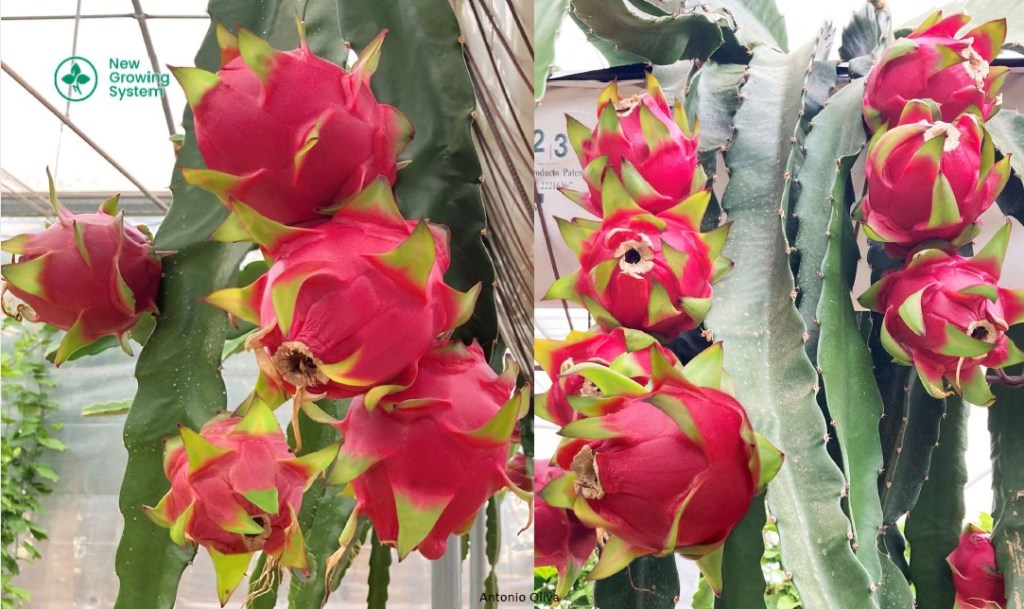At the moment, pitaya (Caramel of Desert variety) is the main crop we are growing in our hydroponic greenhouses. Why have we chosen this fruit? We have done so because we consider it to be one of the fruits with the highest consumption projection in the coming years. And this is due to the continuous improvement in the quality of the product that growers are generating. In addition to its enormous health benefits.
The pitayaalso known as pitahaya o dragon fruithas its origins in Central America. Although it has been known and described among botanists since the discovery of the continent by the Spaniards, it is only very recently (1995) that its consumption has become popular in the food sector. Prior to this, it was valued for the ornamental characteristics of the plant and its spectacular appearance during flowering. The big breakthrough came when the Vietnamese government encouraged its farmers to plant and market pitaya. That is why today, it is usually the fruit of Vietnamese origin that populates most of the shelves of European markets.
It is a cactus plant and therefore requires very little water. It is found on the market with its two characteristic outer colours, yellow and red, and its different aspects of the pulp, from white to intense red and pink. As growers have created new hybridisations, the fruit has improved in taste and sweetness.
Nutritional elements
Its appearance is very attractive and its consumption is very easy due to the easy removal of the outer shell. The intense purple hue of some varieties is highly aesthetic. This means that the consumption experience is not only in terms of taste but also in terms of visual aspects.
Average nutritional composition per 100 g.
- Calories: 54
- Water: 84,4 %
- Protein: 1.4 grams
- Fat: 0.40 grams
- Carbohydrate: 13.2 grams
- Fibre: 0.5 grams
- Vitamin C: 8 milligrams
- Calcium: 10 milligrams
- Iron: 1.3 milligrams
- Phosphorus: can be up to 26 milligrams
- It is also noteworthy for its high antioxidant content, in which the following stand out BetalaínasThe Hydroxycinnamates and the Flavonoids

But it is its potent health care possibilities that are the main incentive for its consumption. It has a high water content (about 90% of water) and the pulp is rich in iron, calcium and phosphorus. It is rich in vitamins B, C and E.
Medical articles
The National Libray of Medicine The US government currently has 244 scientific articles on the medical properties of pitaya. The growth in the interest of the scientific community is palpable, going from one article in 2001 to 65 in 2022. Readers interested in reviewing any of these articles can access the NLM website by clicking on the image.

Health benefits of pitaya consumption
- Enhanced production of red blood cells, white blood cells and platelets strengthens the immune system.
- It supports a healthy gut microbiota, which helps to control glucose levels. This makes it suitable for the prevention and treatment of diabetes.
- Iron and vitamin C help to prevent anaemia
- Vitamin C, through the reinforcement of collagen production, is helpful in the optimal maintenance of the muscular and skeletal systems.
- The high antioxidant content is a great remedy against premature ageing.
- Pitaya is a great ally against constipation, as well as facilitating diuresis.
- Its seeds provide essential fatty acids, especially Omega 3. This helps in inflammatory processes and in the fight against cholesterol.
- Its high water content and very low carbohydrate content makes it an essential ally in weight loss diets.
- Vitamin C together with Flavonoids, Polyphenols and Betalains act as antioxidants and anti-inflammatories. This prevents free radical damage to cells, thus protecting against chronic diseases such as cancer, diabetes and arthritis. This combination of elements can also improve our immune system's response to certain viruses and bacteria.
Caramel of Desert
The variety that we grow at Mochana Green is the Caramel of Desert, a hybridisation owned by New Growing System. From our point of view, this variety has the best quality indexes that can be found in the market at the moment. We have planted two varieties of red-fleshed pitaya (Hylocereus sp / Caramel of Desert R1 and R2) and a white-fleshed pitaya (Hylocereus sp / Caramel of Desert R3)
All of them are characterised by producing fruit whose average weight is usually over 400 grams, thus exceeding the average of what we can find on the market. Likewise, the brix degrees that we obtain with them range between 18 and 21, which gives them an exceptional flavour and sweetness.

You can also watch this video article.
